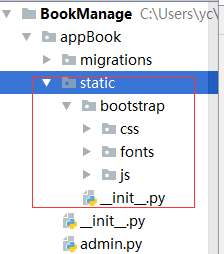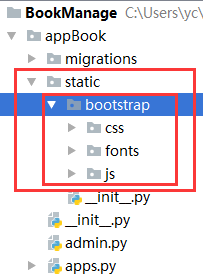1、首先在APP目录下创建一个static文件夹
如图:

# Application definition INSTALLED_APPS = [ 'django.contrib.admin', 'django.contrib.auth', 'django.contrib.contenttypes', 'django.contrib.sessions', 'django.contrib.messages', 'django.contrib.staticfiles', 'appBook.apps.AppbookConfig', ]
2、在settings.py中 最底部添加如下:
# Static files (CSS, JavaScript, Images) # https://docs.djangoproject.com/en/1.11/howto/static-files/ STATIC_URL = '/static/' STATIC_ROOT=( os.path.join(BASE_DIR,"appBook/static"), )
3、在html页面头部添加:

{% load staticfiles %}
<!DOCTYPE html>
<html lang="en">
<head>
<meta charset="UTF-8">
<title>Title</title>
<link rel="stylesheet" href="{% static 'bootstrap/css/bootstrap.css' %}" rel="external nofollow" >
<style>
.container{
margin-top: 80px;
}
</style>
</head>
<body>
4、在html模版页面,可以用如下方式调用:
<img src="{% static 'images/logo.gif' %}" alt=""/>
<img src="/static/images/acer.gif" alt=""/>
推荐使用第二种,因为如果图片名称是动态的,可以通过views这么绑定:
<img src="/static/images/{{name}}.gif" alt=""/> css的引用同样如此: <link rel="stylesheet" href="{% static ‘style/base.css' %}" rel="external nofollow" type="text/css"> <link rel="stylesheet" href="/static/style/base.css" rel="external nofollow" type="text/css"> js的引用同样如此: <script type="text/javascript" src="{% static ‘js/jquery-1.8.3.min.js' %}"/> <script type="text/javascript" src="/static/js/jquery-1.8.3.min.js"/>
可以用 python manage.py findstatic css/index.css 寻找 css
Django:locals()小技巧
locals()返回一个包含当前作用域里面的所有变量和它们的值的字典。
所以可以把views改写为
def current_datetime(request):
current_date = datetime.datetime.now()
return render_to_response('current_datetime.html', locals())
这里要注意的是要把now重命名为current_date,因为模板需要的是这个变量名。
在template是如下定义的:
<html>
<body>
<font color = "blue">It is is now {{ current_date }}.</font>
</body>
</html>
以上就是本文的全部内容,希望对大家的学习有所帮助,也希望大家多多支持自学编程网。

- 本文固定链接: https://zxbcw.cn/post/197356/
- 转载请注明:必须在正文中标注并保留原文链接
- QQ群: PHP高手阵营官方总群(344148542)
- QQ群: Yii2.0开发(304864863)
